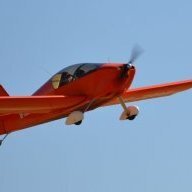Hi Skip,
The reason it is not so important to run the engine at cruise speed during the test run is that the aim is simply to find the vibration amplitude and phase. That vibration will obviously always be at engine speed even though what you feel in the cabin will probably be different at different rpm. In my case, there was a bad vibration in the cabin at 1500 RPM as I pulled the power back. The propeller out-of-balance wasn't worse at 1500 RPM, it just felt worse in the cabin because that is probably the resonant frequency of the engine mounts. The picture below is the vibration spectrum output of the vibration analyser. It plots peak inches/sec against frequency (plotted as RPM) while the engine was running at 1850 RPM. You can see the obvious large peak at 1850 due to prop out-of-balance, as well as a smaller peak at 5550 RPM, (3 x engine speed) due to 3 firing pulses per rev, and a smaller peak at twice engine speed which is possibly due to propeller blade beats.
Fortunately most of that vibration doesn't get through to the cabin. The picture below shows the vibration spectrum measured by a second transducer attached to the instrument panel. Presumably if we had run the test at 1500 RPM the vibration would have been much worse.
The following picture shows the vibration spectrum with a "near enough" set of weights fitted. Brian was able to tell me the optimal weights and locations required, but the Sonex is a little unusual in that it doesn't have a conventional spinner and backing plate. The only place to attach weights is under the propeller bolts. I used a combination of aluminium spacers and AN washers to achieve an approximate balance. Even this rough balance made a dramatic improvement. My 1500 RPM shake was completely eliminated.
Later I made and fitted the accurate weights Brian specified. We got together a couple of months later and recorded the following vibration spectrum at 1825 RPM. Note that the vertical scale is larger than in the earlier graphs. The peak IPS value at engine speed is down to just 11% of the starting value. The other peaks are not worse, just magnified by the graph scale.
This didn't take multiple runs and gradually zeroing in on a minimum value. The analyser came up with a suitable correcting mass and location and it worked. The only way to use a smaller balancing mass would be to locate it further from the centre, not an option on the Sonex. The balance mass had to be on the propeller bolt pitch circle. In my case, the correct balance mass location was part way between two bolts. Again, Brian was able to tell me exactly how much mass to attach to which bolt.






